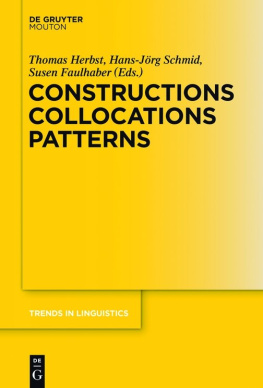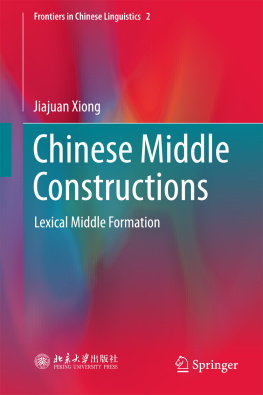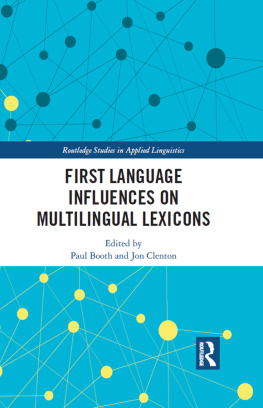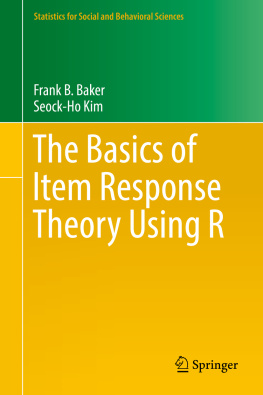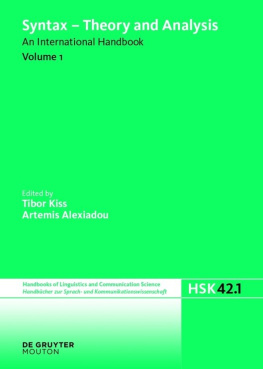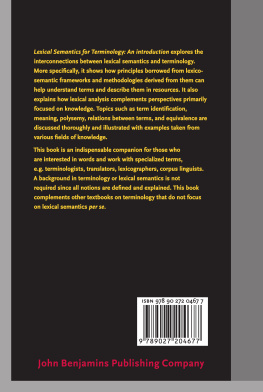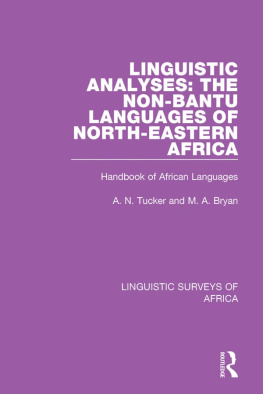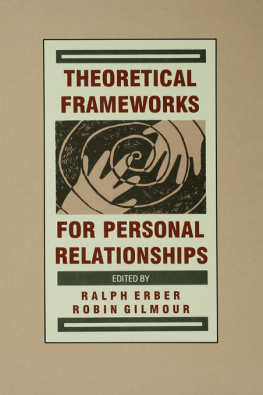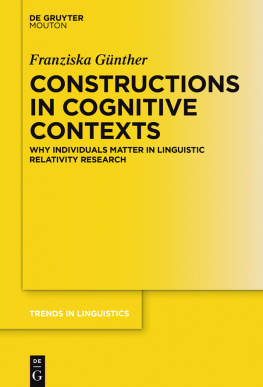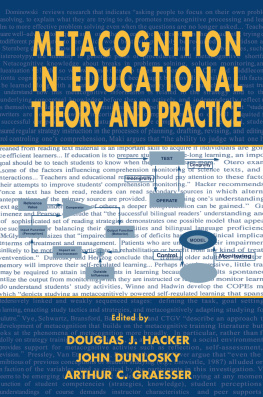Thomas Herbst - Constructions Collocations Patterns
Here you can read online Thomas Herbst - Constructions Collocations Patterns full text of the book (entire story) in english for free. Download pdf and epub, get meaning, cover and reviews about this ebook. year: 2014, publisher: De Gruyter Mouton, genre: Children. Description of the work, (preface) as well as reviews are available. Best literature library LitArk.com created for fans of good reading and offers a wide selection of genres:
Romance novel
Science fiction
Adventure
Detective
Science
History
Home and family
Prose
Art
Politics
Computer
Non-fiction
Religion
Business
Children
Humor
Choose a favorite category and find really read worthwhile books. Enjoy immersion in the world of imagination, feel the emotions of the characters or learn something new for yourself, make an fascinating discovery.
- Book:Constructions Collocations Patterns
- Author:
- Publisher:De Gruyter Mouton
- Genre:
- Year:2014
- Rating:3 / 5
- Favourites:Add to favourites
- Your mark:
- 60
- 1
- 2
- 3
- 4
- 5
Constructions Collocations Patterns: summary, description and annotation
We offer to read an annotation, description, summary or preface (depends on what the author of the book "Constructions Collocations Patterns" wrote himself). If you haven't found the necessary information about the book — write in the comments, we will try to find it.
This volume, which has textbook character, is intended to provide an in-depth introduction to different theoretical and methodological research frameworks concerned with the role of item-specific grammatical and lexical behaviour.
Constructions Collocations Patterns — read online for free the complete book (whole text) full work
Below is the text of the book, divided by pages. System saving the place of the last page read, allows you to conveniently read the book "Constructions Collocations Patterns" online for free, without having to search again every time where you left off. Put a bookmark, and you can go to the page where you finished reading at any time.
Font size:
Interval:
Bookmark:
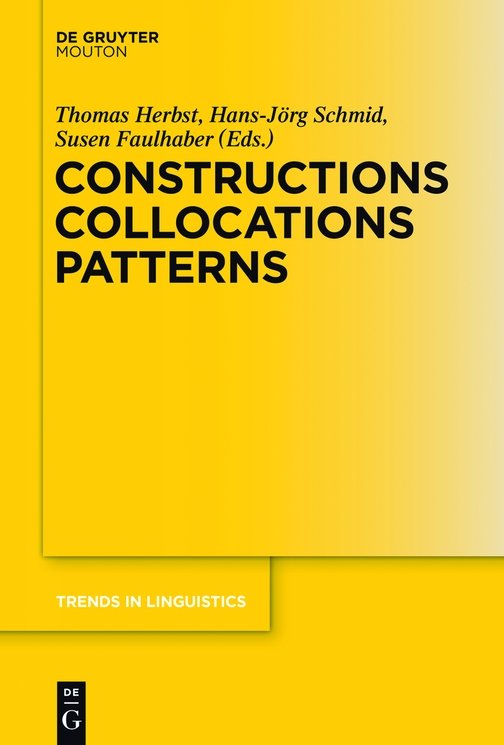
Elena Lieven
Ambridge and Lieven (2011) provides an exhaustive comparison.
During infancy there is developing sensitivity to the patterning of different features of language: newborns are already able to make a number of discriminations based on prosodic features in their ambient language and they develop increasing sensitivity to both the prosody and phonology of their surrounding language(s) over the first year of life (Curtin and Tomasello et al. 2005). Once this development is underway, children can begin to map what they are hearing to the meaning they infer that it conveys and then attempt to reproduce this when they themselves are trying to communicate.
Children start by learning phonologically specific chunks mapped to child-extracted meanings. These strings can be of varying length from word, word plus inflection(s) and multiword strings, and this will partly depend on the language being learned. If the strings are of high abstraction. Developing networks of form-meaning mappings become connected in multiple ways (through both form and function). Constituency and more complex syntax emerge through this process.
There are important methodological implications that derive from this approach. Because we do not credit the child with pre-given, abstract linguistic categories from the outset, we only posit the existence of an abstract Theakston 2009).
In this chapter, I first discuss the structure of the input and how this may assist learning. In and I illustrate this in network to either support the learning of new constructions or to compete with it.
We know that there are significant correlations with many aspects of CDS and childrens language development. Parents who elaborate on the childs focus of attention have children with larger vocabularies (Kidd et al. 2007).
CDS is a genre with a number of well-established characteristics: utterances tend to have exaggerated prosody, to be shorter than those addressed to adults, to concentrate on the here-and-now and to have a relatively high proportion of questions and imperatives all of which makes perfect sense from the point of view of communicating with a two-year-old. In a study of 12 English-speaking childrens development between 2;03;0, Cameron-Faulkner, Lieven and Tomasello (2003) found that only 18% of CDS utterances were in canonical SVO word order, while 32% were questions and 15% were copulas. The authors then analysed the first 13 words of each utterance in these categories and defined a frame whenever the same word or string of words occurred at the beginning of utterances more than 4 times. They found that 77% of copula utterances were accounted for by just 8 frames and 67% of questions by 20 frames. Of course this is not surprising: it is explained by the fact that English has only a limited range of wh -words and auxiliaries, and that inversion applies only to the copula and auxiliaries in English (unlike German, where main verbs can be inverted). However it means that children are hearing a very great deal of repetition at the beginnings of utterances and that this might aid them in extracting frames with slots. Indeed the study found that 45% of the mothers utterances began with one of 17 words and that 52 core frames (frames used by more than half the mothers) accounted for 51% of all utterances. Examples of frames are A X, Its a X , What do X ?, Are you X ?, Lets X .
However compared to many other languages, English has more rigid word order and very impoverished morphology. This could mean that it is easier for children to extract slot and frame patterns from what they hear in English input than it would be in other languages. In a study using methods very similar to Abbot-Smith and Lieven (2009) analysed English, German and Russian CDS for the presence of frames at the beginnings of utterances. They found differences deriving from the typological differences between the languages: the absence of the copula in the present tense in Russian and of determiners meant that the Russian data had a higher proportion of shorter frames than English or German; and the presence of OVS word order and main verb inversion in German reduced the overall number of frames per mother. At the same time, the level of repetitiveness at the beginnings of utterances, as measured by the proportion of utterances accounted for by frames, was high for all three languages over 70%. Again, this almost certainly reflects a common approach to interaction with two-year-olds in these groups of mothers.
A rather different approach to the potential of frames in CDS to assist language learning was pioneered by number of different categories. Thus das was used as a pronoun if it was followed by a verb or an adverb, but was used as a determiner if it was followed by a noun or a pronoun. A second possibility suggested by Mintz (2003) is that languages with more flexible word order than English might give better categorisation accuracy if the analysis was based on morphemes rather than words. This latter is an important point: many languages of the world have far more elaborate morphology than the Indo-European or East-Asian languages such as Chinese and Japanese, which have been the main focus of study to date. For instance, Chintang, until recently, an undocumented, polysynthetic, Tibeto-Burman language of Eastern Nepal, has around 2000 verbal inflections. Children learning this language are more likely to extract morphological frames than word-based frames (Stoll et al. 2012).
Bannard, Lieven and Tomasello (2009) worked in the opposite direction by building grammars out of the first 28 hours of each childs speech at each age and then analysing how well these grammars could account for the utterances in the last two hours of the abstraction develops and that for English-speaking children, the first abstraction of a linguistic category is an emergent noun category. It was also interesting that each childs grammar did very badly at parsing the other childs at 2;0 but the 3;0 grammars did much better at parsing the other corpus. This suggests that childrens grammars at 2;0 can be rather idiosyncratic but, by 3;0, they are converging on the grammar of the adult language.
In this approach constituency develops out of the form to function mapping of the slots. For instance, as noted above, in the Lieven et al. (2009) study, most slots in the schemas at 2;0 are the names of people or objects produced as bare nouns. But depending on each childs level of language, these referential slots also contained nouns preceded by the determiners a or the and a few adjectives, and, in the case of the child with the most complex language, other determiners and a wider range of adjectives. Once there is a slot in the schema with a referent function, the child can proceed to build up more complex forms of referring. At the same time, the fact that many schemas are used by the child to refer ( Gimme X , Thats an X , Theres an X ; I want X) will contribute to both the form and the function of the noun phrase becoming more abstract with its own internal slots for determiners and adjectives. It is this process that eventually allows the child to treat a relative clause such as the boy who is smoking as one referential entity mapped to one constituent.
What about verbs? In his (1992) study of his daughters early utterances with verbs (Akhtar and Rowland 1998). These subcategories could then contribute to the generalisation of the verb slot in argument structure constructions as well as building up emergent categories of arguments (e.g. subject) if some of the schemas contain the same verbs. Secondly, there is a great deal of controversy and subsequent research as to how early children do, in fact, show abstract knowledge of verb argument structure.
Font size:
Interval:
Bookmark:
Similar books «Constructions Collocations Patterns»
Look at similar books to Constructions Collocations Patterns. We have selected literature similar in name and meaning in the hope of providing readers with more options to find new, interesting, not yet read works.
Discussion, reviews of the book Constructions Collocations Patterns and just readers' own opinions. Leave your comments, write what you think about the work, its meaning or the main characters. Specify what exactly you liked and what you didn't like, and why you think so.

